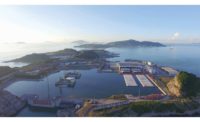Constraints include the need to cast entire sections of the 79 standard elements in single pours to ensure watertightness, says Lykke. While the work requires specialist skills, the contractors also must demonstrate the capacity to handle the scope of work and extended logistics, he adds.
For example, the two tunnel contractors will work from opposite coasts, 18 km apart, while sharing the same element production yard, located on reclaimed land near landfall at Rødbyhavn on the Danish side, says Lykke. Around 3 million cu m of reinforced concrete will be poured at the site.
By the time contracts are awarded next year, the two countries expect to have provided all necessary approvals. Permitting takes the form of legislation in Denmark and regulations in Germany, says Lykke.
Chinese Connection
Some 9,000 km away, meanwhile, a consortium led by China Communications Construction Co. Ltd. (CCCC) is placing elements—each weighing over 75,000 tonnes—on the 6-km-long ITT that will form part of the road crossing of the Pearl River estuary, from Hong Kong to Macao and Zhuhai, according to a report from the site.
The 29.6-km, mostly elevated link to the Hong Kong border is due to open in about two years at an estimated cost of $6.1 billion. It is being procured by Hong Kong-Zhuhai-Macao Bridge Authority, which is controlled by the government of Guangdong and the Special Administration Regions of Hong Kong and Macao.
The tunnel will run between two 650-m-long artificial islands, one of them on the Hong Kong border. The link will continue onto dry land in Hong Kong on a 9.4-km-long viaduct, which is being financed by Hong Kong and built by local subsidiaries of Paris-based Bouygues Construction S.A. and China Harbour Engineering Co. Ltd.
CCCC is close to completing the casting of the 13th of the project’s 33 elements. It immersed the 10th in late March, according to Tommy Olsen, chief project manager at Denmark's COWI A/S, the contractor’s international design firm. A local company is handling detailed design, he adds.
Weighing over 75,000 tonnes each, the 180-m-long elements are 38 m wide and 10 m tall.
Unexpected sedimentation levels complicated the four-day operation to place the first ITT element in early May 2013, according to Netherlands-based Tunnel Engineering Consultants, which is advising the Chinese government. Otherwise, says Olsen, “construction is on track.”







Post a comment to this article
Report Abusive Comment